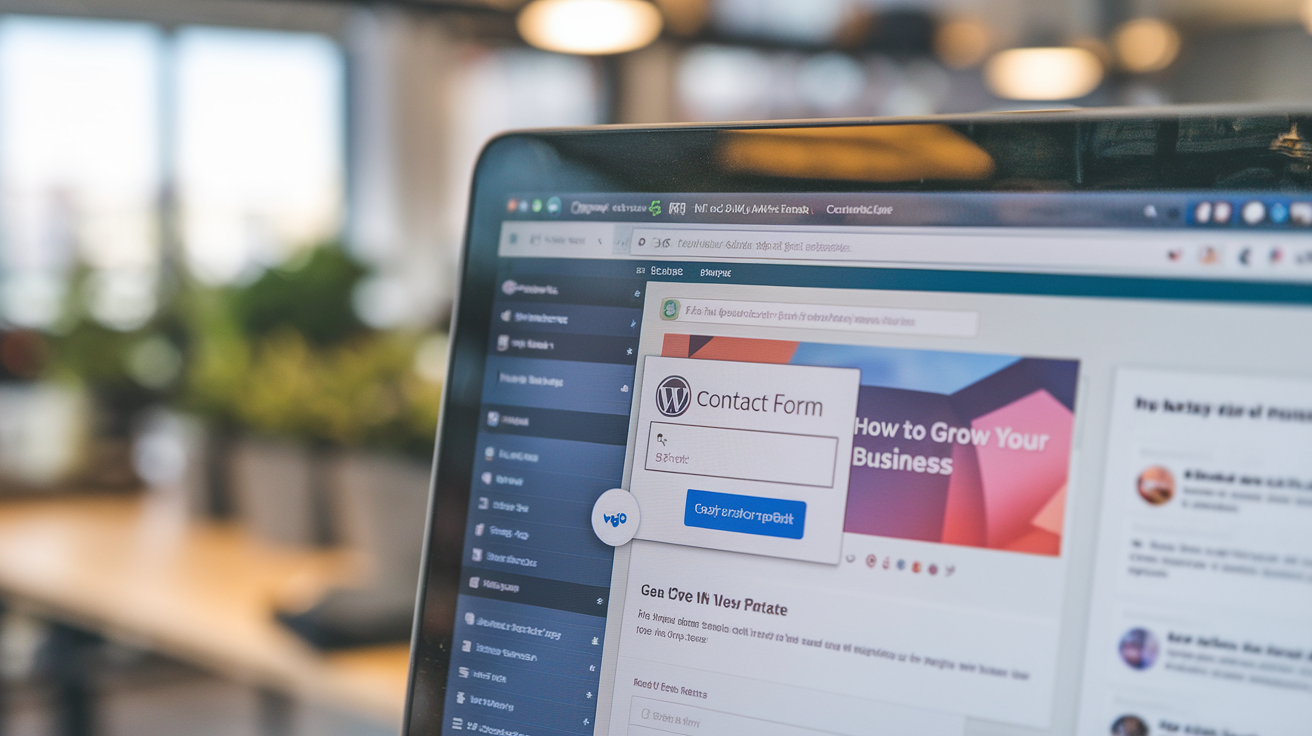
In today’s digital world, having a website is essential for any business or personal brand. But if you’re wondering how to make your own website without coding skills, don’t worry—creating a website is more achievable than ever thanks to accessible tools and platforms designed for beginners.
Whether you’re launching a startup, sharing a personal project, or building a portfolio, this guide will walk you through each step. From choosing the right platform to designing a user-friendly layout, we’ll explore everything you need to get started without any technical background.
By the end, you’ll have the knowledge and confidence to build a functional, professional-looking website that reflects your unique style and meets your goals—all without writing a single line of code.
Why Building Your Own Website is Beneficial
A strong online presence isn’t just a plus—it’s essential. Building your own website gives you control over how you represent your brand or project, allowing you to connect directly with your audience on your own terms. Whether you’re a startup founder, freelancer, or creative, a website provides an effective platform to showcase your work, sell products, or simply share your vision with the world.
Benefits of Building Your Own Website
- Cost Savings: Hiring a professional web developer can be costly, especially for startups or small projects. By creating your own website, you save significantly on setup costs while achieving a result that meets your goals.
- Creative Control: When you design your website, you decide on the look, feel, and overall experience. Every design choice—from layout to color scheme—reflects your unique brand identity, offering a personalized touch that may be harder to achieve with pre-packaged services.
- Flexibility and Independence: Building and managing your website lets you update content as needed, anytime. Whether you’re adding new products, updating a blog, or refreshing design elements, this flexibility is invaluable, especially for fast-evolving startups.
For more insights on setting a strong online foundation, check out our article on 10 Essential Tips for Building a Website for Startups.
Planning Your Website’s Purpose, Audience, and Content
Before diving into design or choosing a platform, it’s essential to start with a clear plan. Defining your website’s purpose, identifying your target audience, and mapping out essential content will ensure that your website is structured and engaging from the start.
Define Your Website’s Purpose
Ask yourself: What is the primary purpose of my website? Different types of websites serve different goals, so being clear on your objectives will help you prioritize features and design elements. Here are a few common website purposes:
- Portfolio: Perfect for freelancers, designers, writers, or anyone showcasing their work. This type of site emphasizes visual appeal and provides examples of past projects.
- E-commerce: If you’re selling products or services, your website will need a user-friendly shopping experience with secure payment options.
- Informational: Often used for blogs, educational platforms, or service-based businesses, these sites prioritize content that educates, informs, or engages visitors.
Identify Your Target Audience
Knowing who will visit your site is essential. Are you aiming to reach potential clients, customers, or collaborators? Define your audience’s demographics, interests, and online behavior. This information will guide design decisions, language tone, and functionality, ensuring that your website resonates with the people who matter most.
Create a Content Blueprint
Once you know your website’s purpose and target audience, it’s time to outline the core sections that will bring your vision to life. Here are some essential pages and elements to consider:
- Home Page: Your first impression, with a clear message and an inviting design.
- About: Share your brand story, mission, and values to build trust with visitors.
- Services/Products: Detail what you offer, using clear descriptions and visuals.
- Contact: Make it easy for visitors to reach you with a dedicated contact form or page.
- Blog: Regular content updates keep your site fresh, improve SEO, and provide value to visitors.
For a deeper understanding of how to maintain brand consistency across these sections, check out Why Brand Identity and Brand Guidelines Matter for Success.
Planning with a solid purpose, a defined audience, and a thoughtful content structure will make the actual building of your website smoother and more effective, setting you up for success from the beginning.
Choosing a Platform – No Coding Required!
If you’re ready to build your own website without touching a single line of code, you’re in luck! Several beginner-friendly platforms make it possible to create a professional and functional website on your own. Let’s take a closer look at the top options, factors to consider, and some helpful tips to get started.
Best Platforms for No-Code Website Building
These platforms offer a range of tools and templates that make it easy to create your own website:
- Wix: Known for its drag-and-drop interface, Wix is ideal for beginners looking for simplicity. It provides an extensive library of templates, and you can customize each element with just a few clicks.
- WordPress: While slightly more advanced, WordPress offers unmatched flexibility and scalability. With numerous plugins and themes, WordPress can grow alongside your business, adapting to changing needs and industry trends.
- Squarespace: Popular for its sleek, designer-quality templates, Squarespace works well for portfolios, personal brands, and small businesses. It’s intuitive and visually oriented, making it an excellent choice for those focused on aesthetics.
Factors to Consider When Choosing a Platform
Choosing the right platform depends on several factors, including ease of use, customization options, SEO-friendliness, and scalability. Here’s what to consider:
- Ease of Use: If you’re new to web development, choose a platform that’s intuitive and doesn’t require much technical know-how. Both Wix and Squarespace excel in ease of use, with straightforward drag-and-drop editors that allow you to visually arrange elements.
- Customization Options: For a unique look, you’ll want a platform that offers flexibility in design and layout. WordPress, in particular, offers thousands of themes and plugins, giving you almost limitless customization options.
- SEO-Friendliness: Good SEO is crucial for driving traffic to your website. Platforms like WordPress are highly customizable for SEO, allowing you to optimize your site to rank well on search engines. If SEO is a priority, check out this Moz guide on optimizing your site to learn more about the benefits of choosing an SEO-friendly platform.
- Scalability: Your website needs may grow over time. WordPress is often favored by those planning for long-term scalability, as it supports everything from basic blogs to complex e-commerce setups. However, if you’re starting with a smaller budget and simpler needs, Wix and Squarespace also offer scalable features, albeit with some limitations compared to WordPress.
Tip for Beginners: Match Platforms to Your Needs
Each platform has its strengths, so choose one that aligns with your goals and comfort level:
- If you’re looking for simplicity: Wix is a solid choice with plenty of templates and an easy-to-use editor.
- For flexibility and growth potential: WordPress is your best bet, especially if you want to build your own website with plenty of customization options.
- If aesthetics are a priority: Squarespace is ideal for creatives or businesses focusing on visual appeal.
Selecting the right platform is a crucial step when you create your own website, as it influences everything from design capabilities to SEO potential. With these user-friendly platforms, you’ll have the tools you need to create a polished and professional website that fits your vision and goals.
How to Make Your Own Website – Step-by-Step Guide

Focused on building a website from scratch, this beginner is diving into the essentials of web design.
Now that you’ve chosen your platform, it’s time to dive into the essential steps to build your own website. This section breaks down each step to ensure a smooth and efficient process. By following these steps, you’ll be on your way to understanding how to make your own website that’s both professional and user-friendly.
Step 1: Choose a Domain Name
A domain name is your website’s unique address on the web. Here are some tips for selecting a domain name that best represents your brand:
- Keep it Simple: Choose a name that’s easy to spell, pronounce, and remember.
- Reflect Your Brand: The domain name should align with your business name or reflect your industry.
- Consider Extensions: While .com is the most popular, consider others like .net or .io if your preferred .com is taken.
Once you’ve chosen a name, you can check its availability on sites like Namecheap or GoDaddy and purchase it directly.
Step 2: Secure Hosting
Hosting is the service that keeps your website accessible online. When selecting hosting, consider factors like reliability, speed, and customer support. Here are a few popular types:
- Shared Hosting: Affordable but shares resources with other websites. Suitable for small startups or personal projects.
- VPS Hosting: A virtual private server offering dedicated resources, suitable for websites with growing traffic.
- Managed WordPress Hosting: If you’re using WordPress, managed hosting handles maintenance tasks, like updates and security.
Platforms like Bluehost, SiteGround, and WP Engine are popular choices. Take some time to explore their offerings to find one that suits your budget and needs.
Step 3: Install and Set Up Platform
With your domain and hosting ready, it’s time to set up your website platform. Here’s a quick overview for the top platforms:
- WordPress: Most hosting providers offer one-click installation for WordPress. Once installed, you’ll have access to the WordPress dashboard, where you can start building your site.
- Wix: Wix simplifies the setup process, guiding you through creating an account and choosing a template directly on their website.
- Squarespace: Similar to Wix, Squarespace offers an easy onboarding process that lets you choose a design and add content immediately.
Each platform has its unique setup, so follow the specific prompts, and you’ll be up and running in no time.
Step 4: Select a Template or Theme
Your website’s template or theme sets the tone for your brand’s online presence. Here’s how to choose a theme that aligns with your vision:
- Stay Aligned with Your Brand: Whether you’re building a professional or playful website, choose a theme that reflects this.
- Prioritize Simplicity and Usability: Make sure the theme has a clean layout with clear navigation.
- Check for Mobile-Responsiveness: Many visitors access websites from mobile devices, so choose a responsive theme.
For those considering more tailored design assistance, explore The Ultimate Guide to Choosing the Right Website Design Agency to find expert design support that matches your brand’s needs.
Step 5: Add Essential Content
To create your own website, focus on adding high-quality content to essential pages:
- Homepage: Offer a brief introduction, your unique value proposition, and clear calls-to-action.
- About Page: Share your brand’s story, mission, and values to connect with visitors.
- Services/Products Page: Describe your offerings, including features, benefits, and pricing.
- Contact Page: Make it easy for users to get in touch by providing an email, phone number, or contact form.
Step 6: Optimize for SEO and Launch
Once your site is designed and populated with content, optimizing it for search engines is key to attracting visitors:
- Add Relevant Keywords: Place target keywords naturally within your titles, meta descriptions, and headings.
- Optimize Images: Reduce image file sizes to enhance loading speed, and add alt text for accessibility.
- Create Internal Links: Link to related pages within your site to guide visitors and improve SEO. For instance, check out our guide on startup website essentials.
When everything’s set, hit “publish” and celebrate—you’ve just completed how to make your own website! By following these steps, you’re equipped to build your own website that’s optimized, user-friendly, and ready to impress.
Designing Your Website’s Layout and Visuals
Now that you’ve got the structure in place, let’s focus on the visual design and layout—core elements that will shape how users experience your website. When you build your own website, your design should reflect your brand’s identity while keeping user experience (UX) at the forefront. Here’s how to create your own website with an effective design that leaves a lasting impression.
Core Elements of Design
A cohesive and well-thought-out design helps communicate professionalism and build trust with visitors. Here are some essentials to consider:
- Layout: Choose a layout that feels clean and uncluttered. Keep key information above the fold (the portion visible without scrolling) to capture attention immediately.
- Color Scheme: Your color choices should reflect your brand’s personality. A well-chosen color palette can evoke emotions, build brand recognition, and make your site visually engaging.
- Fonts: Fonts are also a significant part of your brand’s image. Select fonts that are easy to read and align with your brand’s tone, whether that’s playful, professional, or elegant.
- Images and Visuals: High-quality images and graphics contribute to an engaging design. Use visuals that are relevant to your content and represent your brand accurately.
User Experience (UX) Tips
A successful website isn’t just visually appealing; it’s also user-friendly. Good UX design will guide visitors seamlessly through your site, helping them find what they need with minimal effort. Here are some UX principles to keep in mind as you create your own website:
- Intuitive Navigation: Use a clear and straightforward menu structure. Visitors should be able to find key pages, like About, Services, and Contact, easily.
- Mobile Responsiveness: With the majority of users browsing from mobile devices, ensuring your site adapts to different screen sizes is essential. A mobile-responsive design enhances user engagement and improves your search engine rankings.
- Clear Calls-to-Action (CTAs): Strategically place CTAs on each page to encourage actions, like “Contact Us,” “Learn More,” or “Get Started.” These buttons guide visitors and make it easy for them to engage with your business.
Brand Consistency
Consistency across design elements, such as colors, fonts, and logos, strengthens your brand’s identity and makes your site memorable. Each visual element should align with your branding to reinforce recognition and professionalism. For a deeper dive into creating a cohesive brand, explore What Makes Online Branding Effective.
Here’s how to maintain brand consistency as you build your own website:
- Logos: Place your logo in prominent areas, like the header or footer, to reinforce brand visibility.
- Color Palette: Stick to a consistent color palette across all pages to establish a unified look. This also contributes to brand recall for returning visitors.
- Typography: Use the same fonts throughout the site. Consistent typography creates a polished, cohesive look that aligns with your brand’s tone and message.
By incorporating these design principles, you’ll create your own website that not only looks great but also offers a seamless user experience. A well-designed site fosters trust and engagement, making visitors more likely to stay, explore, and ultimately take action.
Crafting Content That Engages and Converts
As you build your own website, one of the most critical steps is crafting content that speaks directly to your audience and encourages them to take action. Effective content goes beyond simple information; it tells your brand story, builds trust, and provides valuable insights that keep visitors engaged. Here’s how to create your own website content that captivates and converts.
Content Essentials
When it comes to website content, certain pages are essential for presenting a complete picture of your brand. Here are the must-have pages and what they should include:
- Homepage: This is often the first page visitors see, so make a strong impression. Highlight your unique value proposition, showcase key offerings, and include clear calls-to-action (CTAs).
- About Page: Tell your brand’s story. Share your mission, vision, and values to help visitors connect with your purpose and personality.
- Services or Products Page: Detail your offerings in a way that addresses customers’ needs. Be clear about benefits and features, and use concise descriptions.
- Contact Page: Make it easy for visitors to reach out. Include a contact form, email, phone number, and possibly a map if you have a physical location.
SEO Basics
To make your website visible in search results, you’ll need some foundational SEO knowledge. Fortunately, SEO can be beginner-friendly when broken down into manageable steps, even for those with no coding background.
- Keywords: Use relevant keywords naturally throughout your content. This helps search engines understand your site’s topics and rank it for relevant searches.
- Meta Descriptions: Write concise, descriptive summaries for each page, and include your primary keyword. Meta descriptions provide a snapshot of your content in search results, encouraging clicks.
- Image Optimization: Compress images for faster loading, and add descriptive alt text to help search engines understand what each image represents.
For more in-depth guidance on SEO strategies, check out this external resource from Ahrefs that covers essential SEO practices.
Tone and Messaging
The tone of your website’s content should reflect your brand’s personality and speak directly to your audience. Consistent tone and messaging enhance brand recognition and help build trust with visitors.
- Identify Your Brand Voice: Is your brand friendly, professional, or playful? Establishing a consistent voice will guide your content creation and help you connect with your target audience.
- Stay Consistent: Ensure that every piece of content on your site maintains the same tone, from blog posts to product descriptions. Consistency reinforces your brand’s identity.
- Engaging CTAs: Each page should have a clear CTA. Phrases like “Learn More,” “Get Started,” or “Contact Us” prompt readers to take the next step in their journey with your brand.
By following these content principles, you’ll create your own website with information that not only engages visitors but also converts them into loyal customers. Whether it’s your homepage or a product description, well-crafted content is essential to building trust, enhancing user experience, and achieving your site’s goals.
Adding Essential Features Without Coding

A WordPress contact form setup for increased user interaction and lead generation, essential for businesses looking to grow online.
Once you build your own website with a solid foundation and engaging content, adding essential features can elevate its functionality, user experience, and search visibility. The best part? Many of these enhancements require no coding skills and can be implemented using plugins, add-ons, or built-in features on popular platforms. Here’s how to create your own website with essential features that optimize usability, boost security, and enhance SEO.
Key Functionalities to Enhance User Experience
A website’s functionality directly impacts user satisfaction. With plugins and add-ons, you can easily introduce features that keep users engaged and encourage interaction.
- Contact Forms: Make it simple for visitors to reach out by adding a contact form to your site. Many platforms have form-builder plugins, like WPForms on WordPress, that allow you to customize forms without any code.
- Image Galleries and Media: Showcase your work, products, or projects with visually appealing galleries. Tools like NextGEN Gallery for WordPress allow you to add image galleries and slideshows.
- Social Media Integration: Integrating social media icons and share buttons allows visitors to engage with your brand across multiple platforms. This can be done using simple plugins, helping you extend your reach.
Beginner-Friendly SEO Plugins
Effective search engine optimization is crucial for driving organic traffic, but it doesn’t have to be complicated. Using SEO plugins designed for beginners, you can optimize your website for search engines with minimal effort.
- Yoast SEO (WordPress): This popular plugin makes SEO simple by guiding you through key elements like meta descriptions, keywords, and readability scores. Yoast provides feedback on each page’s SEO and helps you follow best practices, so you rank higher in search results.
- Rank Math (WordPress): Another beginner-friendly option, Rank Math, offers advanced features like keyword tracking and SEO analysis while remaining user-friendly. Both plugins support how to make your own website visible to a broader audience by optimizing each page.
Security and Performance Enhancements
Maintaining website security and performance is essential to protect user data and ensure a smooth experience. Here are a few ways to boost both without any coding.
- SSL Certificates: Secure Socket Layer (SSL) certificates are essential for encrypting data and building user trust. Most platforms or hosting providers offer easy SSL installation, often included in their packages, adding the “https” to your URL for a secure browsing experience.
- Caching and Speed Optimization: Fast load times are critical for retaining visitors. Plugins like WP Super Cache or Autoptimize for WordPress help reduce load times by caching your pages and optimizing code.
- Regular Backups: Protect your content by regularly backing up your site. Plugins like UpdraftPlus automatically save your site data, so you can restore it if issues arise.
Adding these essential features ensures your website is fully functional, user-friendly, and optimized for search engines. By using plugins and built-in platform tools, you can create your own website that performs well, looks professional, and provides a secure experience for your visitors—all without touching a line of code.
With the right mix of plugins, you’ll set up a website that not only meets your goals but also keeps users engaged and satisfied.
Testing and Launching Your Website
After all the hard work of creating content, designing layouts, and adding features, it’s time to test and launch your website. Proper testing ensures your site delivers a seamless user experience across all devices and browsers, which is essential to build your own website successfully. Here’s how to wrap up your project and launch with confidence.
Testing Tips: Ensuring Device and Browser Compatibility
As you create your own website, it’s vital to verify that it functions smoothly for all users, regardless of device or browser. Here are some essential testing steps:
- Cross-Device Testing: Ensure your website is mobile-friendly by testing it on various devices, such as smartphones, tablets, and desktops. Most website platforms offer previews for different screen sizes, but testing on actual devices is recommended for accuracy.
- Browser Compatibility: Test your website on major browsers, including Chrome, Firefox, Safari, and Edge. Differences in browser rendering can sometimes affect the appearance or functionality of certain elements.
- Navigation and Links: Go through each page to confirm that all links and menu items work as intended. Broken links or missing buttons can frustrate visitors, so double-check all internal and external links.
Pre-Launch Checklist: Final Touches for a Smooth Launch
Before going live, run through this checklist to make sure your website is fully optimized and polished:
- Page Load Speed: Ensure fast loading times by optimizing images and minimizing large files. Speed can impact both SEO and user experience, so it’s crucial to address any delays.
- SEO Basics: Review each page’s SEO settings. Check that all meta descriptions, keywords, and alt text are in place and optimized. Using SEO plugins can streamline this process and help boost your site’s visibility.
- Readability and Spelling: Go over your content to confirm it’s clear, concise, and free of grammatical errors. It’s easy to overlook typos, so consider using proofreading tools or asking a colleague to review your content.
- SSL and Security: Double-check that your SSL certificate is active, ensuring your website is secure for visitors.
Launching and Promoting Your Website
Once testing is complete, it’s time to launch. A well-promoted launch can generate excitement and attract your target audience to your new website.
- Social Media Sharing: Announce your website’s launch on social media platforms like Facebook, LinkedIn, and Instagram. Include a compelling description and a clear link to drive visitors to your site.
- Email Newsletter: Send an email to your subscribers, introducing them to your new website. Highlight what they can expect to find, such as helpful resources, new products, or an exciting blog section.
- Collaborate and Network: Reach out to industry influencers or partners who may be interested in sharing your website with their followers. Networking is a powerful way to expand your reach and build credibility.
Completing these steps prepares your site for a successful launch, ensuring a smooth experience for your audience. Testing thoroughly and promoting effectively are key to making sure all the effort to build your own website translates into a positive, impactful launch.
Now that you know how to make your own website and have taken all necessary steps for a successful launch, you’re ready to share your brand with the world. Embrace this final phase with enthusiasm, and watch your website connect with new audiences and help you reach your goals.
Post-Launch Maintenance and Updates
After the excitement of launching, your work doesn’t end there. Regular maintenance and updates are essential to ensure your site remains secure, engaging, and functional. Once you build your own website, keeping it updated and performing optimally is crucial to sustain growth and retain visitors.
Importance of Regular Updates and Maintenance
Maintaining a website goes beyond its initial setup. When you create your own website, you’ll need to prioritize regular updates to keep it secure and relevant. Key aspects include:
- Security Checks: Regular updates help protect your site against potential security threats. Ensure that any plugins, themes, and platforms you use are updated promptly to guard against vulnerabilities.
- Backups: Set up regular backups so you can quickly recover your site if any issues arise. Many platforms and hosting providers offer automatic backup options, allowing you to safeguard your content without manual effort.
- Performance Optimization: Over time, images, plugins, and other elements can slow down your site. Regularly review page load times and optimize any large files or outdated plugins to keep your website running smoothly.
Keeping Content Fresh and Relevant
To engage your audience and maintain good search engine rankings, it’s important to update your website content periodically. Here’s how you can keep your site’s information valuable and up-to-date:
- Blog and Article Refresh: Keep your blog active by posting new content regularly. This can include industry updates, tutorials, or engaging stories that reflect your brand. If you create your own website with a blog section, frequent posts help boost SEO and engage returning visitors.
- Product or Service Updates: If your business evolves with new offerings, make sure to update your website to reflect these changes. This ensures that your visitors have accurate, up-to-date information.
- Content Revisions: Periodically review your core pages (like About, Services, and Contact) to ensure they accurately represent your brand’s vision and current goals. Small updates to your messaging can go a long way in keeping your website relevant and trustworthy.
Monitoring Performance with Analytics
Tracking your website’s performance helps you understand what’s working and where improvements can be made. For those who build your own website, understanding analytics is crucial to making data-driven decisions.
- Google Analytics: Install Google Analytics to monitor visitor data, such as traffic sources, user demographics, and popular pages. This tool provides insights into which content resonates most with your audience.
- User Behavior: Analytics can show you how visitors interact with your site, identifying pages where users may drop off or spend less time. Use this information to improve user experience and optimize poorly performing pages.
- SEO Performance: Track keyword rankings, bounce rates, and other SEO metrics to determine how well your site is performing in search engine results. This information can guide content updates and adjustments for improved SEO.
By implementing these post-launch practices, you’ll ensure that the work you put into how to make your own website continues to pay off. Regular updates, fresh content, and performance monitoring keep your site relevant and engaging, helping your website remain a strong asset as your brand grows.
DIY vs. Hiring a Web Development Company

Choosing between DIY and hiring a web development company can shape your online presence. Here’s what to consider for building your website.
When it comes to managing your website, you have two main options: maintaining a DIY approach or hiring a professional web development company. Deciding between the two depends on factors like your budget, goals, technical knowledge, and the scale at which you want to grow your site. Here’s a breakdown to help you understand when it’s best to build your own website and when professional help might be essential.
DIY Approach: The Pros and Cons
If you’ve opted to create your own website, you’re likely using beginner-friendly platforms like WordPress, Wix, or Squarespace. These platforms allow non-tech users to design functional websites without coding expertise. Here’s what to consider:
Pros of DIY:
- Cost-Effective: DIY platforms are often more budget-friendly, ideal for startups or personal projects with limited funds.
- Creative Control: With a DIY website, you can manage updates, design tweaks, and content at your own pace.
- Quick Launch: For simple websites, DIY platforms offer quick setup options, allowing you to build your own website and get online fast.
Cons of DIY:
- Limited Customization: While DIY builders are versatile, they may lack the advanced customization options required for complex features or scaling.
- Time-Consuming: If you’re handling everything solo, maintaining the site, managing updates, and troubleshooting can be time-consuming.
- Potential SEO and Performance Limitations: DIY platforms may not always provide robust SEO tools, which can affect your site’s performance and visibility.
Hiring a Web Development Company: When It’s the Right Choice
For certain projects, investing in a professional web development company can offer advantages that go beyond the DIY approach, especially if you’re aiming to grow your website in terms of functionality and reach. Here’s why hiring a professional can be beneficial:
Advantages of Hiring a Web Development Company:
- Customization and Scalability: If you’re looking for advanced features, complex integrations, or unique branding, an agency provides the expertise to bring that vision to life.
- SEO and Performance Optimization: Professionals can help with on-page and technical SEO, ensuring that your website ranks well on search engines and loads quickly. This is especially valuable if you want your site to compete effectively.
- Long-Term Support: Agencies often offer maintenance and support packages to handle regular updates, security checks, and troubleshooting, freeing up your time to focus on other aspects of your business.
When to Consider a Web Development Company:
- Scaling Beyond the Basics: If your website needs custom features, such as e-commerce capabilities or a membership portal, an agency has the resources and knowledge to implement these elements effectively.
- Building a Strong Brand Presence: A web development company can ensure your site aligns with your brand’s identity and long-term goals, making it a memorable and trusted platform.
- Time Constraints: If you’re short on time or lack technical skills, outsourcing to professionals can fast-track your project without compromising quality.
If you’re considering hiring an agency for added support, check out our article on Finding the Perfect Web Development Company for Your Startup to explore more about partnering with a professional team.
Making the Choice: DIY or Professional?
Choosing between DIY and hiring a web development company depends on your startup’s specific needs and future growth plans. Starting with a DIY approach is often sufficient for simple websites, allowing you to create your own website with limited upfront costs. However, as your business scales, a professional web development agency can take your site to the next level, adding features and functionality to meet evolving demands.
Ultimately, knowing how to make your own website is a valuable skill, but leveraging the expertise of professionals can help you create a powerful, scalable online presence that supports your business’s growth for years to come.
Conclusion
Building a website has never been easier, and for startups or personal projects, understanding how to make your own website with no coding skills can open up a world of opportunities. With today’s tools, you can create your own website that’s not only visually appealing but also functional and responsive.
Let’s recap the steps to build your own website:
- Define your goals and audience so your site speaks directly to your target visitors.
- Choose the right platform for ease of use and scalability.
- Design a cohesive brand and intuitive layout that enhance user experience.
- Create engaging content and optimize it for SEO to improve visibility.
- Add essential features like CTAs and social media links to drive engagement.
- Test thoroughly before launching, ensuring your website performs well across devices.
- Maintain and update your site regularly for security, performance, and fresh content.
For beginners, experimenting with no-code tools is a fantastic way to get hands-on with your vision. And if you ever feel the need for advanced customization, don’t hesitate to reach out to a web development company for support. Your website is a key part of your brand, so whether you build your own website or collaborate with professionals, make sure it reflects your unique goals and values.
Frequently Asked Question’s
1. How long does it take to build your own website with no coding skills?
The time needed to create your own website without coding varies based on the platform and complexity. For a simple site on platforms like Wix or Squarespace, you can have it live in a few hours. However, to build your own website with more customization or e-commerce features, you may spend a few days or weeks refining the details.
2. What is the best platform for a beginner to create your own website?
For beginners learning how to make your own website, platforms like Wix, Squarespace, and WordPress.com are excellent choices. They offer easy drag-and-drop interfaces, built-in templates, and features ideal for non-coders, giving you the flexibility to build your own website without technical knowledge.
3. How much does it cost to make a website without coding?
Costs can vary based on the platform and features. Basic plans on DIY platforms range from $10–$30 per month. For those who want to build your own website with premium features, custom domains, and e-commerce capabilities, the price can go up to $100 or more monthly. However, these platforms still remain cost-effective compared to custom development.
4. How can I make my website look professional?
To create a professional-looking website, focus on cohesive design elements: use a clean layout, consistent color scheme, and high-quality images. User-friendly navigation, mobile responsiveness, and strategic use of call-to-action (CTA) buttons are essential. How to make your own website look professional often starts with choosing a well-designed template and customizing it with your brand’s visuals and messaging.
5. What are the benefits of hiring a web development company?
While DIY platforms are excellent for beginners, a web development company can offer advanced customization, unique branding, and technical support. Hiring professionals is ideal if you need complex functionalities or want a website that can scale with your business. A web development company also ensures that aspects like SEO, security, and performance are optimized, saving you time and providing peace of mind as you build your own website for long-term success.
Ready to dive in? Whether you decide to DIY or consult a web development company, this guide gives you the confidence to create a website that fits your needs. Happy building!







